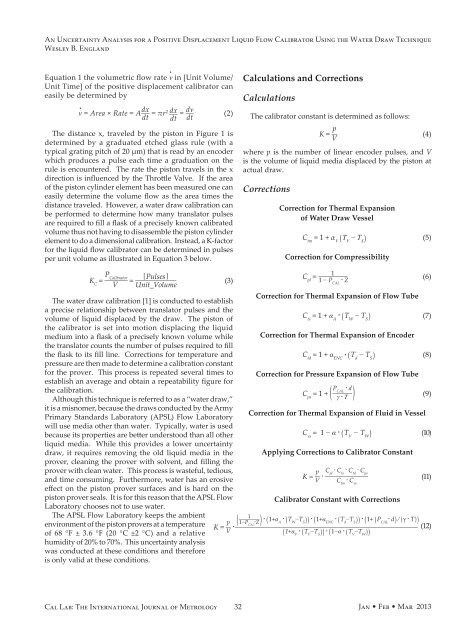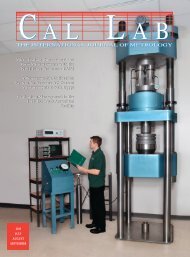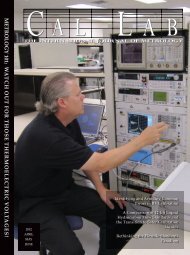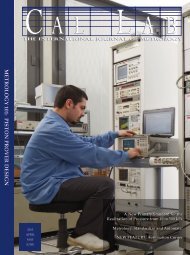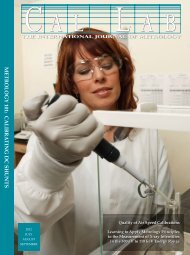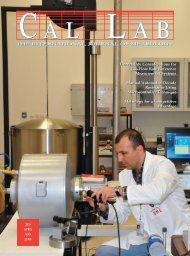Magazine – PDF - Cal Lab Magazine
Magazine – PDF - Cal Lab Magazine
Magazine – PDF - Cal Lab Magazine
You also want an ePaper? Increase the reach of your titles
YUMPU automatically turns print PDFs into web optimized ePapers that Google loves.
An Uncertainty Analysis for a Positive Displacement Liquid Flow <strong>Cal</strong>ibrator Using the Water Draw TechniqueWesley B. EnglandEquation 1 the volumetric flow rate v in [Unit Volume/Unit Time] of the positive displacement calibrator caneasily be determined byv = Area × Rate = A ___ dx = πr2 ___ dxdt dt = ___ dvdt . (2)The distance x, traveled by the piston in Figure 1 isdetermined by a graduated etched glass rule (with atypical grating pitch of 20 µm) that is read by an encoderwhich produces a pulse each time a graduation on therule is encountered. The rate the piston travels in the xdirection is influenced by the Throttle Valve. If the areaof the piston cylinder element has been measured one caneasily determine the volume flow as the area times thedistance traveled. However, a water draw calibration canbe performed to determine how many translator pulsesare required to fill a flask of a precisely known calibratedvolume thus not having to disassemble the piston cylinderelement to do a dimensional calibration. Instead, a K-factorfor the liquid flow calibrator can be determined in pulsesper unit volume as illustrated in Equation 3 below.<strong>Cal</strong>culations and Corrections<strong>Cal</strong>culationsThe calibrator constant is determined as follows:K = p __V (4)where p is the number of linear encoder pulses, and Vis the volume of liquid media displaced by the piston atactual draw.CorrectionsCorrection for Thermal Expansionof Water Draw VesselC tm= 1 + α V( T V− T S ) (5)Correction for CompressibilityK C= _______P <strong>Cal</strong>ibrator =____________ [ Pulses ]V Unit_Volume (3)The water draw calibration [1] is conducted to establisha precise relationship between translator pulses and thevolume of liquid displaced by the draw. The piston ofthe calibrator is set into motion displacing the liquidmedium into a flask of a precisely known volume whilethe translator counts the number of pulses required to fillthe flask to its fill line. Corrections for temperature andpressure are then made to determine a calibration constantfor the prover. This process is repeated several times toestablish an average and obtain a repeatability figure forthe calibration.Although this technique is referred to as a “water draw,”it is a misnomer, because the draws conducted by the ArmyPrimary Standards <strong>Lab</strong>oratory (APSL) Flow <strong>Lab</strong>oratorywill use media other than water. Typically, water is usedbecause its properties are better understood than all otherliquid media. While this provides a lower uncertaintydraw, it requires removing the old liquid media in theprover, cleaning the prover with solvent, and filling theprover with clean water. This process is wasteful, tedious,and time consuming. Furthermore, water has an erosiveeffect on the piston prover surfaces and is hard on thepiston prover seals. It is for this reason that the APSL Flow<strong>Lab</strong>oratory chooses not to use water.The APSL Flow <strong>Lab</strong>oratory keeps the ambientenvironment of the piston provers at a temperatureof 68 °F ± 3.6 °F (20 °C ±2 °C) and a relativehumidity of 20% to 70%. This uncertainty analysiswas conducted at these conditions and thereforeis only valid at these conditions.1C pl= ________1 − P CAL· ZCorrection for Thermal Expansion of Flow Tube(6)C ts= 1 + α A· ( T W− T S ) (7)Correction for Thermal Expansion of EncoderC td= 1 + α ENC · ( T d− T S ) (8)Correction for Pressure Expansion of Flow TubeC ps= 1 + ( P CAL · d ______γ · T ) (9)Correction for Thermal Expansion of Fluid in VesselC vs= 1 − α · ( T V− T W ) (10)Applying Corrections to <strong>Cal</strong>ibrator ConstantK =__ p V · ____________C · C · C · C pl ts td ps (11)C tm· C vs<strong>Cal</strong>ibrator Constant with CorrectionsK = __ p (_______ 1V · 1−P CAL·Z ) · ( 1+α · ( T −T ) ) · ( 1+α · ( T −T ) ) · ( 1+ ( P · dA W S ENC d S CAL )⁄ ( γ · T ) )__________________________________________________ (12)( 1+α V· ( T V−T S ) )· ( 1−α · ( T V−T W ) )<strong>Cal</strong> <strong>Lab</strong>: The International Journal of Metrology32 Jan • Feb • Mar 2013


